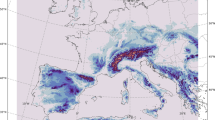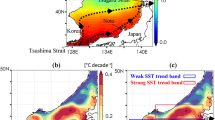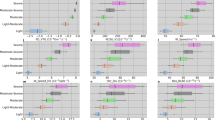Abstract
The feedback of an arctic polynya, which is a large ice-free zone within the sea ice, on the hemispheric climate is studied with the ECMWF T21 GCM. For this purpose a control and an anomaly integration, in which a polynya was introduced in the Kara Sea, are compared. As the GCM, like the real atmosphere, shows a high level of low frequency variability, the mean response to the changed boundary conditions is obscured by internal noise. The necessary significance analyses are thus performed to enhance the signal-tonoise ratio within the framework of an a priori chosen guess pattern and a multivariate test statistic. The sensible and latent heat fluxes increased above the polynya, which resulted in a warming of the lower troposphere above and near the polynya. No statistically significant local or global sea-level pressure changes are associated with this heating. However we find a significant change of hemispheric extent of the geopotential fields at 300 hPa, if we use as guess patterns the eigenmodes of the barotropic vorticity equation. The different mean flow field is accompanied by significant changes of the synoptic transient eddy field. We find a significant variation in the barotropic and baroclinic forcing of the mean flow by the eddies, a change in the location and intensity of the storm tracks and in the conversion between eddy available and eddy kinetic energy. The additional heat flux from the polynya results in a reduction of the meridional heat flux by the synoptic eddies on the western Atlantic.
Similar content being viewed by others
References
Barnett TP, Preisendorfer RW, Goldstein LM, Hasselmann K (1981) Significance tests for regression model hierarchies. J Phys Oceanogr 11:1150–1154
Egger J (1977) On the linear theory of atmospheric response to sea surface temperature anomalies. J Atmos Sci 34:603–614
Fischer G (ed) (1987) Climate simulations with the ECMWF T21model in Hamburg. Large Scale Atmospheric Modelling Report, Universität Hamburg, FRG
Fletcher JO, Mintz Y, Arakawa A, Fox T (1971) Numerical simulation of the influence of Arctic sea ice on climate. WMO Tech Note No 129, Proc. IAMAP/IAPSO/WMO Symp. Energy Fluxes of Polar Surfaces, Moscow, 181–218
Frankignoul C (1985) Sea surface temperature anomalies, planetary waves, and air-sea feedback in the middle latitudes. Rev Geophys 23:357–390
Hasselmann K (1979) On the signal-to-noise problem in atmospheric response studies. Meteorology over the Tropical Oceans. Roy Met Soc London, pp 251–259
Hense A (1986) Multivariate statistical analysis of the Northern Hemisphere circulation during El Nino 1982/83. Tellus 38A:189–204
Hense A, Glowienka-Hense R, von Storch H, Stabler U (1990) Northern Hemisphere atmospheric response to changes of Atlantic Ocean SST on decadal time scales: a GCM experiment. Clim Dyn 4:157–174
Hermann GF, Johnson WT (1980) Arctic and Antarctic climatology of a GLAS general circulation model. Mon Wea Rev 108:1974–1991
Hoskins BJ, James IN, White GH (1983) The shape, propagation and mean-flow interaction of large-scale weather systems. J Atmos Sci 40:1595–1612
Lautenschlager M, Schlese U (1989) Atmospheric response to ice age conditions — climatology near the Earth's surface. Large Scale Atmospheric Modelling Report 7, Universitat Hamburg, 233–243
Martin S, Cavalieri DJ (1989) Contributions of the Siberian shelf polynyas to the Arctic Ocean intermediate and deep water. J Geophys Res 94:12725–12738
Mitchell JFB, Hills TS (1986) Sea ice and the Antarctic winter circulation: a numerical experiment. Quart J Roy Met Soc 112:953–969
Mitchell JFB, Senior CA (1989) The Antarctic winter: simulations with climatological and reduced sea ice extents. Quart J Roy Met Soc 115:225–246
Royer JF, Planton S, Déqué M (1990) A sensitivity experiment for the removal of Arctic sea ice with the French spectral general circulation model. Clim Dyn 5:1–17
Simmonds I, Budd WF (1990) A simple parameterization of ice leads in a GCM and the sensitivity of climate to a change in Antarctic ice concentration. Annales Glac 14:266–269
Simmonds I, Dix M (1987) Comment on ‘Sea ice and the Antarctic winter circulation: a numerical experiment’ by JFB Mitchell and TS Hills. Quart J Roy Met Soc 113:1396–1403
Simmonds 1 (1979) The effect of sea ice on a general circulation model of the Southern Hemisphere. Sea Level, Ice, and Climatic Change (Proc of the Canberra Symposium) IAHS Publ no 131:193–206
Storch H von (1987) A statistical comparison with observations of control and El Nino simulations using NCAR CCM. Contr Phys Atmos 60:464–477
Storch H von (ed) (1988) Climate simulations with the ECMWF T21-Model in Hamburg Part 11: Climatology and sensitivity experiments. Large Scale Atmospheric Modelling Report 4, Universitat Hamburg, FRG
Storch H von, Zwiers F (1988) Recurrence analysis of climate sensitivity experiments. J Clim 1:157–171
Warshaw M, Rapp RR (1973) An experiment on the sensitivity of a global circulation model. J Appl Met 12:43–49
Webster PJ (1981) Mechanisms determining the atmospheric response to sea surface temperature anomalies. J Atmos Sci 38:554–571
Williams J, Barry RG, Washington WM (1974) Simulation of the atmosphere using the NCRA global circulation model with ice age boundary conditions. J Appl Met 13:305–317
Zwiers F, Storch H von (1989) Multivariate recurrence analysis. J Climat 2:1538–1553
Author information
Authors and Affiliations
Rights and permissions
About this article
Cite this article
Glowienka-Hense, R., Hense, A. The effect of an arctic polynya on the Northern Hemisphere mean circulation and eddy regime: a numerical experiment. Climate Dynamics 7, 155–163 (1992). https://doi.org/10.1007/BF00211157
Received:
Accepted:
Issue Date:
DOI: https://doi.org/10.1007/BF00211157




